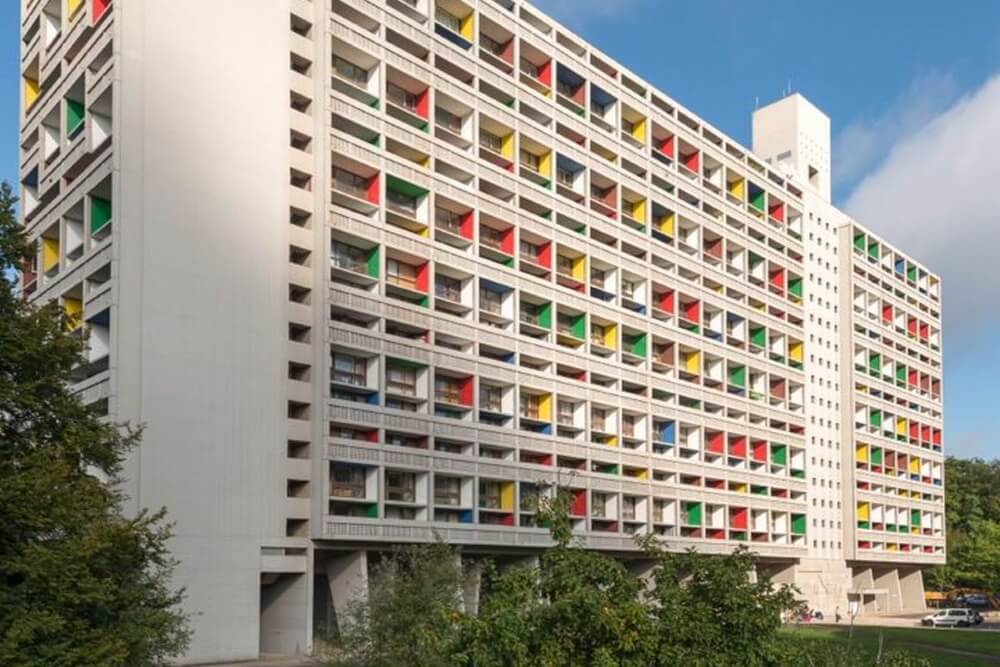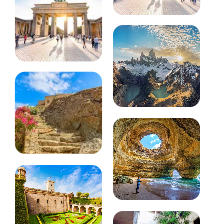Cité Radieuse Le Corbusier in Marseille

Built in the heart of Marseille in the Bouches-du-Rhône region between 1947 and 1957, the Cité Radieuse was the brainchild of the famous architect Le Corbusier.
Listed as a historic monument since 1986, the Cité Radieuse revolutionised building architecture with its extraordinary design. Located at 280 boulevard Michelet in Marseille’s 8th arrondissement, the residence is surprisingly colourful, and can be visited all year round by booking with the Marseille Tourist Office.
Between the Corniche and the Pointe Rouge, the Cité Radieuse is a must-see if you’re ever in Marseille.
La cité Radieuse – Le Corbusier, outstanding architecture
Built on concrete stilts, the aim of this building was to “show a new art of building that transforms the way people live”, with 5 main axes: stilts, roof-garden, free plan, window-band and free facade. It was intended to give the impression of a vertical village that would be convivial thanks to its large living spaces. The passageways inside the building are reminiscent of streets, leading to the 337 flats, all of which are duplexes with private terraces.
The large windows let the light in through the flats, and the gardens outside are spacious, perfect for families. There used to be shops and offices.
These have now been replaced by a hotel restaurant, a bookshop, a food store and a school. The playground is located on the roof terrace of the building, and there is also a swimming pool reserved for residents, a gymnasium and a painting workshop.
It has to be said that the unobstructed view over the city of Marseille was in itself a major asset for this large complex.
The 18 levels for 9 floors are perfectly optimised thanks to a well thought-out layout on a human scale, and the view is not over streets, but over the green spaces of the park. Above all, Le Corbusier wanted to create spaces where people felt good and that were comfortable to live in on a daily basis.
La cité radieuse in a few figures
- 36 concrete piles 7 metres high supporting each building,
- 3 hectares of green spaces.
- Accommodation for 2,000 tenants,
- 337 homes, including 23 different types,
- 1 hotel with 21 rooms,
- 137 metres long, 24 metres wide and 56 metres high.
Why was this building built?
During the Second World War, many French cities were bombed and many homes were totally or partially destroyed. In Marseille, the Germans dynamited the Panier district and the port.
The housing crisis, particularly in terms of social housing, had already been a major problem for a long time, but it intensified after the last world war to the point where solutions had to be found to house as many people as possible who were homeless or living in shanty towns. It was at this time that the construction of large housing estates began in response to the urgent need to house the French.
Who was Le Corbusier?
Charles-Edouard Jeanneret-Gris, as he was known, loved to travel to find inspiration and improve his techniques, and was very interested in knowledge from here and elsewhere. A man with a penchant for modernity, he wanted to create functional buildings with clean lines while including nature in his architecture.
As well as being an architect, Le Corbusier was also an urban planner, painter, man of letters and designer.
In his inaugural speech, Le Corbusier said of the Cité Radieuse that it was: “Made for men, made on a human scale, with the robustness of modern techniques, manifesting the new splendour of raw concrete, to put the sensational resources of the time at the service of the home”.
In a career spanning 60 years, Le Corbusier designed a great many buildings in 12 countries on 4 of the 5 continents.
What is the modulor?
It’s a measurement system invented by Le Corbusier in 1945. It consists of mixing the 2 measurement systems generally used at the time: the Anglo-Saxon inch-foot, which is not very practical, but which takes body measurements into account, and the metric system, which is very practical, but which does not take body measurements into account. The aim was to obtain a measurement system that would provide maximum comfort for human beings in their living space. For example:
- Ceiling height: 226 cm
- Table height: 70 cm
- Height of a kitchen unit: 86 cm…
Practical information about visiting the Cité Radieuse Le Corbusier
Tours can be booked through the Marseille tourist office.
Prices
- Guided tour for adults: €10.00
- Guided tour for 6 to 12 year olds: €5.00
- Guided tours for children under 6: free
Reservations are essential, as the city is open to the general public and to groups. Tours depart at 2pm and 4pm from Monday to Friday and on some Saturdays.
You will have the opportunity to visit the housing unit, a listed flat open to the public, the roof terrace and the shopping street, all with a tour guide who will answer all your questions about this extraordinary estate.
After the tour, you’ll have the chance to listen to a recorded audio tour featuring the voices of past and present residents of the Cité Radieuse, who will guide you through the site.
Please bear in mind that this is an inhabited complex, so it’s important to respect the site and its inhabitants.
Little tidbits about the Cité Radieuse…
- Do you know what the people of Marseilles call it? La Maison du Fada, a building of this size on stilts – you should have thought of that!
- The site is a UNESCO World Heritage Site.
- A total of 5 housing units were built on the park.
- At the time of its construction, this housing estate was considered to be a laboratory for a completely new housing system.
200 audioguided tours for cities all around the world
Download
